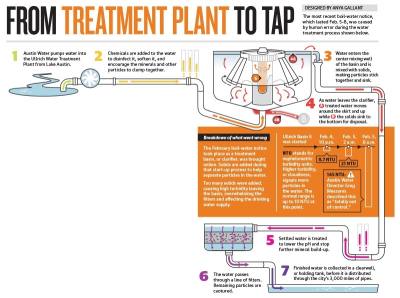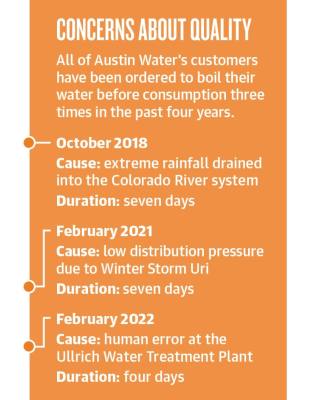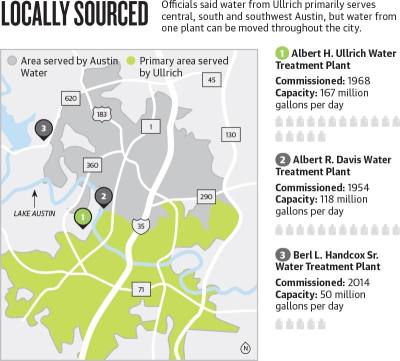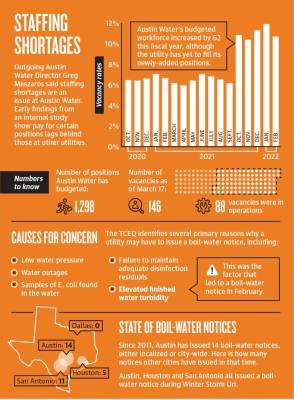Concerns over the possible contamination of Austin’s drinking water supply Feb. 5 prompted the third citywide boil-water notice in less than four years and brought an ongoing shakeup and intense scrutiny to civic utility Austin Water.
After enduring quality notices from other causes in 2018 and 2021, community members and city officials are now seeking answers on how the 11th-largest U.S. city repeatedly failed to reliably provide clean water to its residents after more than a century without experiencing similar issues.
Austin Water is currently searching for new leadership, completing its own review of the February breakdown and anticipating an external audit of its practices.
While in the process of improving its systems, Austin Water is also contending with a continued loss of its most experienced personnel—including Greg Meszaros, its director of 15 years. The utility is faced with ensuring it is resilient enough to supply an ever-growing city.
“This was really about our operations of the plant. How we communicate, how we make decisions, how we respond to alarms, how we escalate. Those are all within our control, and ... ultimately preventable,” Meszaros said Feb. 15. “I’m just profoundly sorry that we had this event.”
Monitoring missteps
Located just west of the Colorado River and Tom Miller Dam, the Ullrich Water Treatment Plant is Austin Water’s largest and most central treatment plant responsible for the daily production of around half of the drinking water in Austin.
Late Feb. 4, one of Ullrich’s seven treatment basins started up as usual but saw rising turbidity levels by early Feb. 5, according to preliminary reviews. Measuring water turbidity, or clarity, is a key piece of treatment monitoring as higher readings can signal potentially harmful microorganisms in water.
By 6 a.m. conditions in Basin 6 were completely out of control. At that point, Meszaros said heavy water clogged up the system and spilled into the clean water supply.
The contamination was officially logged around 8 a.m. Feb. 5, after which Ullrich’s citywide pumping shut down, and water production at Austin Water’s remaining two treatment plants ramped up. By 8 p.m., the city was under its third boil-water notice since 2018.
Austin Water placed the three overnight operators who were on duty during the incident on leave, where they remain pending further discipline. Meszaros resigned Feb. 11.
Austin Water identified operator error at Ullrich as the root cause of the turbidity spike Feb. 4-5. Preliminary reports on the incident said that alarms triggered by increased turbidity were working and did go off as Ullrich’s water grew cloudier Feb. 5.
“There was not a call for help. ... I don’t entirely know why,” Meszaros said.
While no sign of any problem organisms was found in the compromised water, Ullrich’s water systems feed into Austin’s entire supply, and federal regulations require a boil notice to be issued if high turbidity is detected.
“I made the decision. I said, ‘Let’s do a citywide boil-water notice.’ That’s the most protective of the whole city,” Meszaros said.
Notices stack up
Unlike the 2018 boil notice stemming from local flooding and the 2021 notice brought on by the effects of Winter Storm Uri, blame for the 2022 situation appears to lie with Austin Water operators and response policies.
In October 2018, historic flooding in the area kicked up sediments and overwhelmed Austin’s water filtration, leading to Austin’s first ever city-wide boil-water notice. Meszaros and local experts said then that the flooding fallout was beyond Austin’s system capabilities, especially after drought conditions that worsened the sediment issue.
All of Austin once again faced a historic natural disaster in February 2021 with Uri disabling water and power systems statewide. Austin Water, like many other Texas water providers, entered boil-water conditions for around one week due to system failures and infrastructure damage that caused low pressure across the city.
The city has experienced several small-scale and localized boil incidents over the years as well with causes ranging from contaminant concerns to low pressure. Austin Water is typically on the lookout for such issues, and the Texas Commission on Environmental Quality outlines several reasons a utility may have to issue a boil-water notice, including decreased pressure—as in the case of Uri—or the detection of E. coli.
Desmond F. Lawler, a University of Texas engineering professor with water treatment expertise, said he does not see the three recent citywide boil-water notices as a trend or reason for widespread concern about the system. However, he said the human error in February stands alone.
“When a boil-water notice happens because ... of the floods four years ago or when they happen because of massive power losses all over the city as happened 13 months ago, it’s easily chalked up to so-called acts of God—extraordinary circumstances that overwhelm an engineering system,” Lawler said. “When something happens because of human error ... it’s a little bit more difficult to excuse.”
Strengthening systems
Following a series of City Council hearings, officials unanimously voted Feb. 17 to launch an external audit of Austin Water and its activities in recent years. The wide-ranging consultant report could cost between $200,000 and $1 million, and it will focus on areas such as the utility’s management of boil-water events, its best practices, and future planning around Austin’s water supply and management. Council may decide on next steps at its March 30 audit committee meeting.
Mayor Pro Tem Alison Alter sponsored the council resolution initiating the audit, and she said a full-scale review is needed to dig deeper into the utility and restore trust in its work.
“Our community expects and deserves better,” Alter said in a statement.
City staff are expecting to wrap up an internal after-action report on the February event by late March. Meszaros is now expected to depart Austin Water on April 8, and former assistant city manager Robert Goode will take over as the utility's interim director April 11. A national search for a permanent director will begin soon, according to City Manager Spencer Cronk.
While pointing to human error as the main reason behind the early February ordeal, Meszaros and city officials have also outlined other areas of potential improvement to focus on in the near term. Among the top items: strengthening the 54-year-old Ullrich facility and its staff.
“When Ullrich is wobbly, the system is going to be wobbly,” Meszaros told council.
Meszaros said Austin Water’s recent failures are not a result of underinvestment by the city. The utility’s funding has jumped 7.85% since fiscal year 2018-19, with $654.75 million budgeted in FY 2021-22.
Separately, the utility is also in the midst of a multiyear, $1.1 billion improvement plan.
In addition, city management may decide to tack on additional funding this year. Council will decide to either shift several million dollars to support an infrastructure boost—the option supported by Austin Water leadership—or provide a $10 billing credit to residential customers.
As those processes play out, Austin Water is contending with staffing issues that have hit many city departments over the past year-plus. Although it received a 5% bump to its budgeted staff in FY 2021-22, the utility has seen constant attrition at all levels of its workforce. As of March, more than 11% of its 1,298 budgeted positions were vacant.
“Our experience is being diluted,” Meszaros said. “We used to turn around where we’d have a lot of operators that have 20 years’ experience, 25 years’ experience. Those days are gone.”










